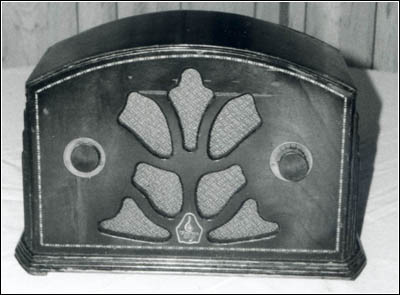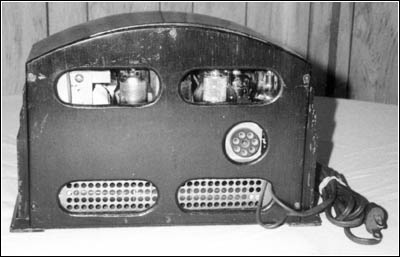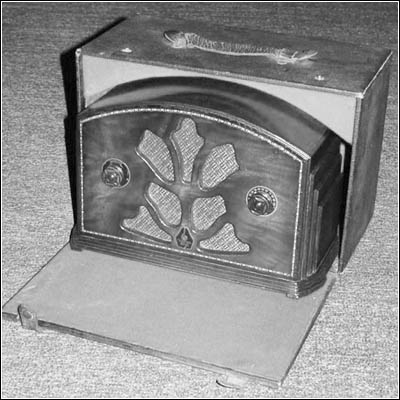Of Old Radios And Related Items--Published Monthly
Emerson Model 25
World's Biggest Selling Little RadioBy Richard Arnold
Web Edition
In this article, Richard Arnold describes the Emerson Model 25 compact radio and tells us how Emerson bet on a payoff from the production of compact sets in the Depression years. (Editor)
From 1924 to 1932 Emerson Radio and Phonograph Corporation distributed radio receivers bearing the name "Emerson" through many diverse channels, including department and sporting goods stores. In 1932, Emerson began to specialize in small receiver sets for home use. One of these sets was the now very collectible and desirable Model 25, shown in Figure 1. This is the first truly compact radio.
The idea for this radio design came to Benjamin Abrams, president of Emerson, while looking at a clock or rather a clock case, handsomely styled, as style was understood in those days. A few attempts had previously been made to produce a set smaller than the "Midget," but nothing quite so small as the clock case. How could public confidence be inspired to by such a hybrid?
The year is 1932 and the fortunes of small radio were at a low state. For some reason the midget sets -- in those days, cathedral and tombstone receivers were considered midget sets -- had failed to hold their own on the market and had lost public favor. Small radio manufacturers were folding about as fast as they had started. Some of the major companies that produced consoles reluctantly continued their midget models to round out their product lines. For all practical purposes, research, engineering and promotion of small radios were dead.
Figure 1. A front view of the Emerson Model 25.Emerson's "New Idea"
At this time Emerson attempted to make a radio smaller than the midget radios that were usually 18" x 15" x 9" in size. This "new idea" radio would be only 10" wide x 61/2" high x 4" deep. The idea of squeezing a radio chassis, along with the tubes, speaker and everything else into a case this small was preposterous, to say the least.
Figure 2 (see print version) compares the size of the "compact" Emerson 25, which is only 61/2" high to my Philco Model 70 cathedral, and my GE-K-52 "midget" cathedral, 13" high. Compared to even the smaller cathedral, the difference is quite impressive.
No standard speakers, condensers, dials, coils or other components were available, nor were any of the suppliers of radio equipment very enthusiastic about making any. It was going to have to be a pioneering job, and Emerson engineers went ahead on their own and overcame many discouraging and seemingly insurmountable difficulties.
By doing so, they developed the first practical and popularly accepted "compact" radio receiver, measuring only 10" x 61/2" x 4 1/2". It has small brass discs behind the knobs; the one on the left says, "increase volume"; the one on the right says, "selector." The dial scale goes from 0 to 100. This set also has a wood inlay behind the knobs, while other versions have only a design behind the knobs and no inlay.
The 1932-1933 Model 25 is a 4-tube TRF (Tuned Radio Frequency) receiver. It uses a Type 39 tube as an RF amp, a Type 36 as a detector and 1st audio, a Type 38 as an audio output, and a Type 37 as a 1/2 wave rectifier wired with its grid and plate tied together. It uses a 5" electromagnetic speaker and weighs in at only six pounds, as compared to the twenty-five plus pound midgets. Figure 3 shows the tightly packed components. The price of the Model 25 was fixed at $25. The going price of other midget radios was around $49.50.
Figure 3. This rear view of the Emerson Model 25 shows its closely packed components.Radio and Merchandising History
With the design and production of the Model 25, Emerson made radio and merchandising history in that the first practical, popularly accepted "Compact" had come into being.
The Emerson Model 25 was presented to the public late in 1932 when the country was at the lowest depth of the Depression. Astounded dealers sold more than two hundred thousand Model 25s in 1932-1933. Orders poured in from all across the country, and for more than a year, orders were greater than production could sustain. Not until the middle of 1933 did production and sales come into balance on this one model alone.
Many manufactures and dealers of the time considered Emerson's small radio a "Depression product," and thought that with the return of prosperity, sales would drop. Instead, sales of small radios climbed to even higher levels in the following years.
One of the many interesting developments, which immediately followed the introduction of the Compact, was a revived acceptance of the Midget. For several years both types, in varying sizes, enjoyed wide sales. Most of the small-set engineering, however, was devoted to the Compact, and the Midget gradually faded out of the picture. Some of the first Model 25s were even altered for 32- and 6-volt battery operation to respond to the growing demand for farm reception. The round half- dollar sized connector seen on the back of this radio's chassis was for the portable or DC operation option. This change may be where the Model 25A designation came from.
Figure 5. The combination Model 25 and its carrying case.Just a little trivia here -- Saks Fifth Avenue in New York, advertised and sold the radio as a "Unique" compact radio. The ad is reproduced as Figure 4 (see print version). For an additional charge of only $10, one could purchase an exclusive pigskin carrying case with a handle, shown in Figure 5. This item was available in the Sports Department on the seventh floor.
By 1935, total production at Emerson of all types of receivers was 5,500,000, of which 2,600,000 were small sets. All of the major radio manufacturers as well as distributors, dealers and the general public, had been forced to take small radio seriously.
For years one of Emerson's slogans was "World's Biggest Selling Little Radio." The company thinking was that it was small radio that built Emerson in the past and it would be so again. "For in small radio the public has a larger variety of products for its choosing, greater value for less money--more easily utilized receivers--and sets for every purpose and every purse."
It is amazing that even though there were so many of these sets made, they are now hard to find. The Model 25 is a very popular radio today.
Well, this one is in my collection. I really do like the style and even more so the history of this small radio. I have it sitting on a table in my radio room where I can enjoy looking at it, and even better, enjoy listening to it.
A special thank you to Mr. Fielding Grigsby, a local collector/friend, for his charitable efforts in getting this radio working for me.
References:
Rider, John F. Perpetual Trouble Shooters Manual, Vol. III, pp. 3-9. New York: John F. Rider, Publisher.
Small Radio, Yesterday and In the World of Tomorrow. New York: Emerson Radio and Phonograph Corporation, December 1943.
(Richard Arnold P.O. Box 275 Lone Grove, OK 73443)
Richard Arnold, a frequent contributor to A.R.C., has been collecting radios since 1985. His interest is primarily in cathedrals and 1920s battery sets, and his collection ranges from crystal sets to a 1928 American Bosch in a Pooley cabinet. His prize is the 1932 Jackson Bell Peter Pan featured in the June 1991 A.R.C.
| [Free Sample] [Books, etc., For Sale] [Subscribe to A.R.C./Renew] [Classified Ads] [Auction Prices] [Event Calendar] [Links] [Home] [Issue Archives] [Book Reviews] [Subscription Information] [A.R.C. FAQ] URL = http://www.antiqueradio.com/Dec06_Arnold_Emerson25.html Copyright © 1996-2006 by John V. Terrey - For personal use only. Last revised: November 29, 2006. For Customer Assistance please contact ARC@antiqueradio.com or call (866) 371-0512 toll free Pages designed/maintained by Wayward Fluffy Publications
Antique Radio Classified |


